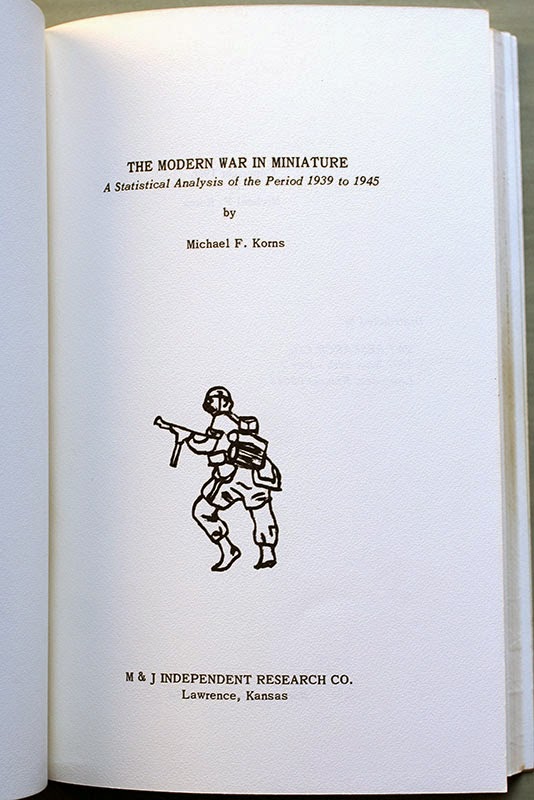When this game was released, The Milton Berle Show was still on the air and the Apollo Program was yet to launch its first, fateful mission.
 |
| Modern War in Miniature by Michael F. Korns |
This is Michael F. Korns' 1966 game Modern War in Miniature (MWIM), probably self-published by Korns and a partner in Kansas under "M & J Research Co." I believe the rules are still available in reprint as part of the book More Wargaming Pioneers from The History of Wargaming Project.
MWIM is an unusual WWII, skirmish-level wargame. As normal, two players act as commanders (one Allied, one Axis), directing their combat units in battle. Miniatures are moved across the terrain on a sand table. What is unusual is that a Judge mediates all actions and is the only one with full access to the sand table. The judge is the only one who needs to know the rules and randomly determines the outcomes of all actions. He talks to the Allied and Axis players individually, out of earshot of each other, describing what they can see and hear in 2-second segments of time. It sort of takes the adversarial roles and judge's mediations of a Braunstein game into short time-span, tactical turns. Everything is on a personal scale making it different from a typical wargame.
 |
| Partial example of gameplay |
Note that any TEXT IN ALL-CAPS is said loud enough for both players to hear. "Schmeisser" is used here as a colloquial term for a German MP38 or MP40 sub-machine gun (which always annoyed me since they were designed by Heinrich Vollmer, not Hugo Schmeisser).
 |
| How to generate random percentile numbers with d6s |
 |
| Small Unit Tactical Combat Referee's Rule Book |
 |
| A Monster Manual of WWII combat forces |
Was MWIM an influence on Gary Gygax? Probably not for Dungeons & Dragons, but according to Peterson, it did insppire Leon Tucker, Gygax's and Mike Reese's co-designer in the development of Tractics.

Very interesting! Thanks for the post.
ReplyDeletelets get this clear
ReplyDeleteyou cannot play MWiM as it lacks the charts, you need SUTC which has the charts ferived from, in patt, MWiM
korns examples of intersction between players and umpire are oh so wrong
i should know. Ned Zupatko, his brother, mysrlf and a group of about five played SUTC to dawns early light and we were forced to develop many non player charts and the proper ways of umpire to player interaction that do not appear in MWiM nor SUTC.
Add to this that we had tp add, completely outside MWiM and SUTC, animals, civilians and trucks/cars and to alter the tank/vehicle damage chart. And that was just a few
The SUTC suggrsted table/play srea is gar too small, especially if armor is involved. Artillery barrages, well, cannot be fone as the shells will kill off everyhing..see the SUTC charts.
Korns didnt write about scenario generation, there are no points assigned to men and weapons, no idea of play balance.
Indeed, thrre is nothing about tactics.
and the sudden death victory condition of a lost leader
And i have had to revide and fill in the midsing stuff, to include using a stopwatch to time the players reactions/actions
MWiM and SUTC were starting points
the other problem is classification, miniatures wargame or RPG
Thanks for your comments, Richard. Please let us know if you ever publish your new charts and modifications to MWiM and SUTC to the public.
Delete"The SUTC sugg[e]sted table/play [a]rea is [f]ar too small..."
What about MWiM's suggested 18 foot by 18 foot sand table?!
"the other problem is classification, miniatures wargame or RPG"
I agree, and that's why I wrote this article. In MWiM, we have a game with very strong role-playing elements published years before the first commercial RPG (D&D) and even before the first Braunstein. It is an anomaly in the history of games.